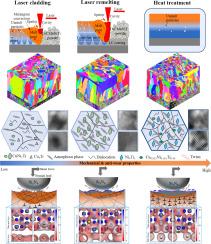熵还原相分离增材制造CuCMnNiTi HEA耐磨涂层
IF 6.8
1区 工程技术
Q1 ENGINEERING, MANUFACTURING
引用次数: 0
摘要
铜基合金具有优异的耐腐蚀性,在工业上得到了广泛的应用,但其较差的硬度限制了其广泛的应用。目前有许多研究集中在调整铜基合金的成分以改善其不足,但传统的“一锅”工艺难以形成纳米晶体,无法在原子水平上提高其硬度。本文首次提出了一种创新的熵还原相分离(ERPS)工艺,并通过熵还原相分离(ERPS)工艺实现了cu基合金高熵合金(HEA)涂层的增材制造,该工艺包括快速成型、相沉淀和增强相稳定三个步骤。采用激光熔覆(LC)法制备CuCNiTiMn HEA涂层,通过激光重熔(LR)和回火处理(TT)在晶界处释放熵并诱导相分离,形成Cu/Ni3Ti纳米晶。在增材制造过程中,C元素有效地抑制了氧化物的形成,Mn稳定了CuCNiTiMn HEA涂层中的Cu/Ni3Ti纳米晶体。采用ERPS法,CuCNiTiMn HEA涂层的硬度(624 HV0.2)比市产Cu-Ni-Ti合金(~ 300 HV0.2)提高了208%,耐磨性(10−7 mm3/N·m)也比市产Cu-Ni-Ti合金(10−5 mm3/N·m)提高了1000倍。该ERPS工艺突破了现有cu基合金的硬度极限,为cu基合金涂层的应用开辟了新的思路。本文章由计算机程序翻译,如有差异,请以英文原文为准。

Additive manufacturing of wear–resistant CuCMnNiTi HEA coating through entropy reduction–phase separation technique
Copper (Cu)–based alloys with superior corrosion resistance are widely applied in industry, but their poor hardness limits their wider application. There are many researches focusing on adjusting the composition of Cu–based alloys to improve their deficiency, but the traditional “one–pot” process is difficult to form nanocrystals, which is unable to improve their hardness at the atomic level. Here, an innovative entropy reduction phase separation (ERPS) process was first proposed, and the additive manufacturing of Cu–based alloy high–entropy alloy (HEA) coating was achieved by the entropy reduction phase separation (ERPS), which included three steps of rapid prototyping, phase precipitation and enhanced phase stabilization. The CuCNiTiMn HEA coating was deposited using laser cladding (LC), and laser remelting (LR) and tempering treatment (TT) were used to release entropy and induce the phase separation at the grain boundaries, where the Cu/Ni3Ti nanocrystalline crystals were formed. During the additive manufacturing process, the C element effectively inhibited the formation of oxides, and the Mn stabilized the Cu/Ni3Ti nanocrystals in the CuCNiTiMn HEA coating. The hardness (624 HV0.2) of CuCNiTiMn HEA coating is increased by 208 % compared with the commercial Cu–Ni–Ti alloy (∼300 HV0.2) by the ERPS process, and the corresponding wear resistance (10−7 mm3/N·m) is also increased by 1000 times compared with the commercial Cu–Ni–Ti alloy (10−5 mm3/N·m). This ERPS process breaks through the hardness limit of the existing Cu–based alloys, which opens up a new idea for the application of Cu–based alloy coatings.
求助全文
通过发布文献求助,成功后即可免费获取论文全文。
去求助
来源期刊

Journal of Manufacturing Processes
ENGINEERING, MANUFACTURING-
CiteScore
10.20
自引率
11.30%
发文量
833
审稿时长
50 days
期刊介绍:
The aim of the Journal of Manufacturing Processes (JMP) is to exchange current and future directions of manufacturing processes research, development and implementation, and to publish archival scholarly literature with a view to advancing state-of-the-art manufacturing processes and encouraging innovation for developing new and efficient processes. The journal will also publish from other research communities for rapid communication of innovative new concepts. Special-topic issues on emerging technologies and invited papers will also be published.
 求助内容:
求助内容: 应助结果提醒方式:
应助结果提醒方式:


